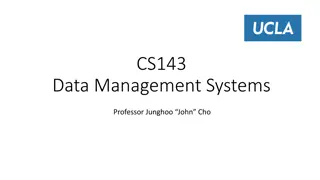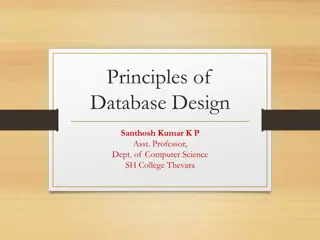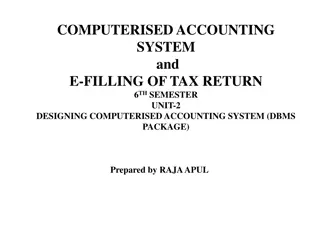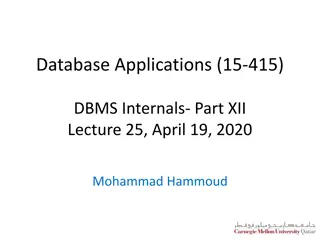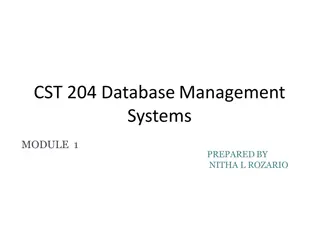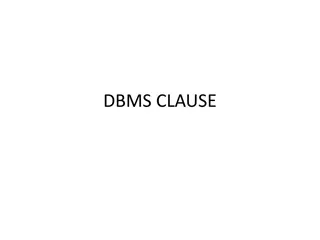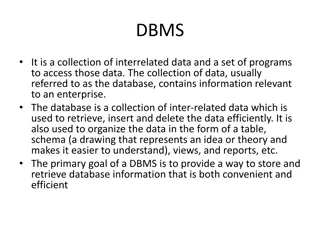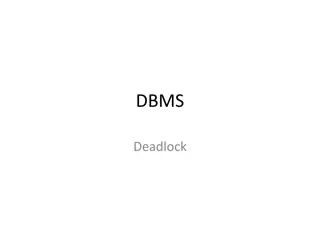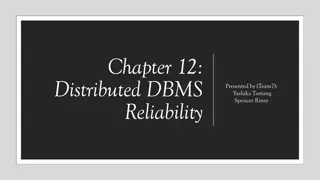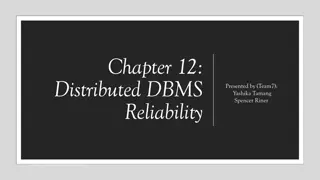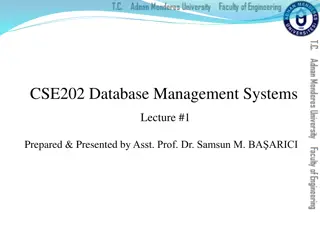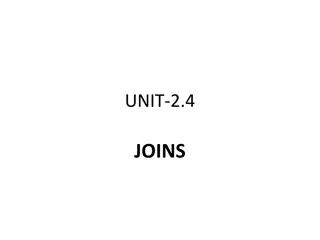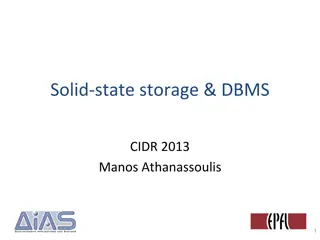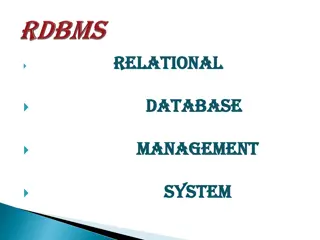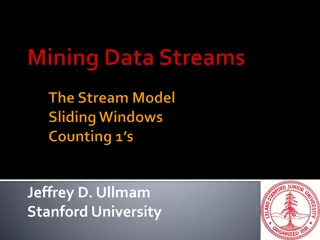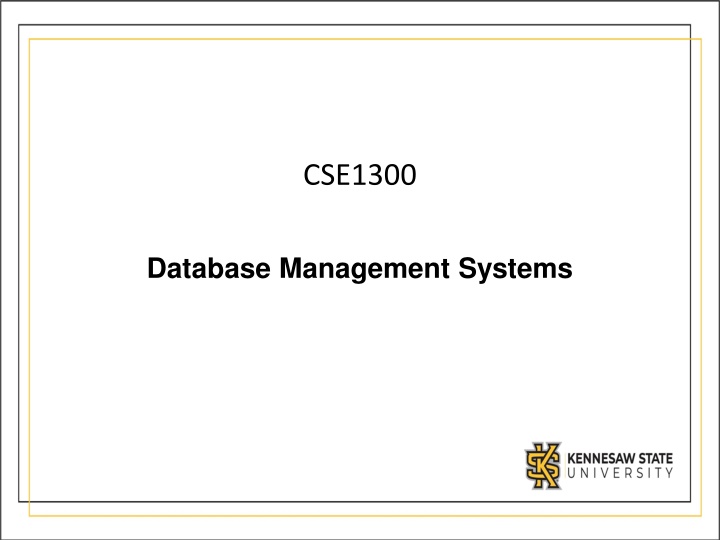
Database Management Systems
Good decisions are based on good information derived from raw data, managed most efficiently when stored in a database. Explore the evolution from computer file systems to modern DBMS solutions that play a vital role in supporting data-driven decision-making and operational efficiency.
Download Presentation

Please find below an Image/Link to download the presentation.
The content on the website is provided AS IS for your information and personal use only. It may not be sold, licensed, or shared on other websites without obtaining consent from the author. If you encounter any issues during the download, it is possible that the publisher has removed the file from their server.
You are allowed to download the files provided on this website for personal or commercial use, subject to the condition that they are used lawfully. All files are the property of their respective owners.
The content on the website is provided AS IS for your information and personal use only. It may not be sold, licensed, or shared on other websites without obtaining consent from the author.
E N D
Presentation Transcript
CSE1300 Database Management Systems
Introduction Good decisions require good information derived from raw facts Data managed most efficiently when stored in a database Databases evolved from computer file systems Understanding file system characteristics is important
Data vs. Information Data are raw facts Information is the result of processing raw data to reveal meaning Information requires context to reveal meaning Raw data must be formatted for storage, processing, and presentation Data are the foundation of information, which is the bedrock of knowledge
Data vs. Information (continued) Data: building blocks of information Information produced by processing data Information used to reveal meaning in data Accurate, relevant, timely information is the key to good decision making Good decision making is the key to organizational survival
Introduction of DBMS (Database Management System) A Database Management System (DBMS) is a software solution designed to efficiently manage, organize, and retrieve data in a structured manner. It serves as a critical component in modern computing, enabling organizations to store, manipulate, and secure their data effectively. From small applications to enterprise systems, DBMS plays a vital role in supporting data-driven decision-making and operational efficiency.
What is a DBMS? A DBMS is a system that allows users to create, modify, and query databases while ensuring data integrity, security, and efficient data access. Unlike traditional file systems, DBMS minimizes data redundancy, prevents inconsistencies, and simplifies data management with features like concurrent access and backup mechanisms. It organizes data into tables, views, schemas, and reports, providing a structured approach to data management. Example: A university database can information, faculty records, and administrative data, allowing seamless retrieval, insertion, and deletion of information as required. store and manage student
Key Features of DBMS 1. Data Modeling: Tools to create and modify data models, defining the structure and relationships within the database. 2. Data Storage and Retrieval: Efficient mechanisms for storing data and executing queries to retrieve it quickly. 3. Concurrency Control: Ensures multiple users can access the database simultaneously without conflicts. 4. Data Integrity and Security: Enforces rules to maintain accurate and secure data, including access controls and encryption. 5. Backup and Recovery: Protects data with regular backups and enables recovery in case of system failures.
Types of DBMS 1. Relational Database Management System (RDBMS) RDBMS organizes data into tables (relations) composed of rows and columns. It uses primary keys to uniquely identify rows and foreign keys to establish relationships between tables. Queries are written Language), which allows for efficient data manipulation and retrieval. Examples: MySQL, Oracle, Microsoft SQL Server and Postgre SQL. in SQL (Structured Query
Types of DBMS 2. Non-Relational or NoSQL DBMS These systems are designed to handle large-scale performance for scenarios where relational models might be restrictive. They store data in various non-relational formats, such as key-value pairs, documents, graphs, or columns. These flexible data models enable rapid scaling and are well- suited for unstructured or semi-structured data. Examples: MongoDB, Cassandra, DynamoDB and Redis. data and provide high
Types of DBMS 3. Object-Oriented DBMS (OODBMS) OODBMS integrates object-oriented programming concepts into the database environment, allowing data to be stored as objects. This approach supports complex data types and relationships, making it ideal for applications requiring advanced data modeling and real-world simulations. Examples: ObjectDB, db4o.
Database Languages Database of commands and instructions used to define, manipulate, and control data within a database. Each language type plays a distinct role in database efficient storage, retrieval, and security of data. The primary database languages include: languages are specialized sets management, ensuring
Data Definition Language (DDL) DDL is the short name for Data Definition Language, which deals with database schemas and descriptions, of how the data should reside in the database. CREATE: to create a database and its objects like (table, index, views, store procedure, function, and triggers) ALTER: alters the structure of the existing database DROP: delete objects from the database TRUNCATE: remove all records from a table, including all spaces allocated for the records are removed COMMENT: add comments to the data dictionary RENAME: rename an object
Data Manipulation Language (DML) DML focuses on manipulating the data stored in the database, enabling users to retrieve, add, update, and delete data. SELECT: retrieve data from a database INSERT: insert data into a table UPDATE: updates existing data within a table DELETE: Delete all records from a database table MERGE: UPSERT operation (insert or update) CALL: call a PL/SQL or Java subprogram EXPLAIN PLAN: interpretation of the data access path LOCK TABLE: concurrency Control
Data Control Language (DCL) DCL commands manage access permissions, ensuring data security by controlling who can perform certain actions on the database. GRANT: Provides specific privileges to a user (e.g., SELECT, INSERT). REVOKE: Removes previously granted permissions from a user.
Transaction Control Language (TCL) TCL commands oversee transactional data to maintain consistency, reliability, and atomicity. ROLLBACK: Undoes changes made during a transaction. COMMIT: Saves all changes made during a transaction. SAVEPOINT: Sets a point within a transaction to which one can later roll back. Data Query Language (DQL) DQL is a subset of DML, specifically focused on data retrieval. SELECT: The primary DQL command, used to query data from the database without altering its structure or contents.
Advantages of DBMS 1. Data organization: A DBMS allows for the organization and storage of data in a structured manner, making it easy to retrieve and query the data as needed. 2. Data integrity: A DBMS provides mechanisms for enforcing data integrity constraints, such as constraints on the values of data and access controls that restrict who can access the data. 3. Concurrent access: A DBMS provides mechanisms for controlling concurrent access to the database, to ensure that multiple users can access the data without conflicting with each other. 4. Data security: A DBMS provides tools for managing the security of the data, such as controlling access to the data and encrypting sensitive data. 5. Backup and recovery: A DBMS provides mechanisms for backing up and recovering the data in the event of a system failure. 6. Data sharing: A DBMS allows multiple users to access and share the same data, which can be useful in a collaborative work environment.
Disadvantages of DBMS 1. Complexity: DBMS can be complex to set up and maintain, requiring specialized knowledge and skills. 2. Performance overhead: The use of a DBMS can add overhead to the performance of an application, especially in cases where high levels of concurrency are required. 3. Scalability: The use of a DBMS can limit the scalability of an application, since it requires synchronization mechanisms to ensure data consistency. the use of locking and other 4. Cost: The cost of purchasing, maintaining and upgrading a DBMS can be high, especially for large or complex systems. 5. Limited Use Cases: Not all use cases are suitable for a DBMS, some solutions don t need high reliability, consistency or security and may be better served by other types of data storage.
Applications of DBMS 1. Enterprise Manufacturing, online retailers. Information: Sales, accounting, human resources, 2. Banking and Finance Sector: Banks maintaining the customer details, accounts, loans, banking transactions, credit card transactions. Finance: Storing the information about sales and holdings, purchasing of financial stocks and bonds. 3. University: Maintaining the information about student course enrolled information, student grades, staff roles. 4. Airlines: Reservations and schedules. 5. Telecommunications: Prepaid, postpaid bills maintanance.
Conclusion A Database Management System (DBMS) is an essential tool for efficiently managing, organizing, and retrieving large volumes of data across various industries. Its ability to handle data securely, ensure integrity, support concurrent access, and provide backup and recovery options makes it indispensable for modern data-driven applications. with complexities and costs, their benefits in terms of data management and security far outweigh the challenges, making them a crucial component in any data-centric environment While DBMSs come


